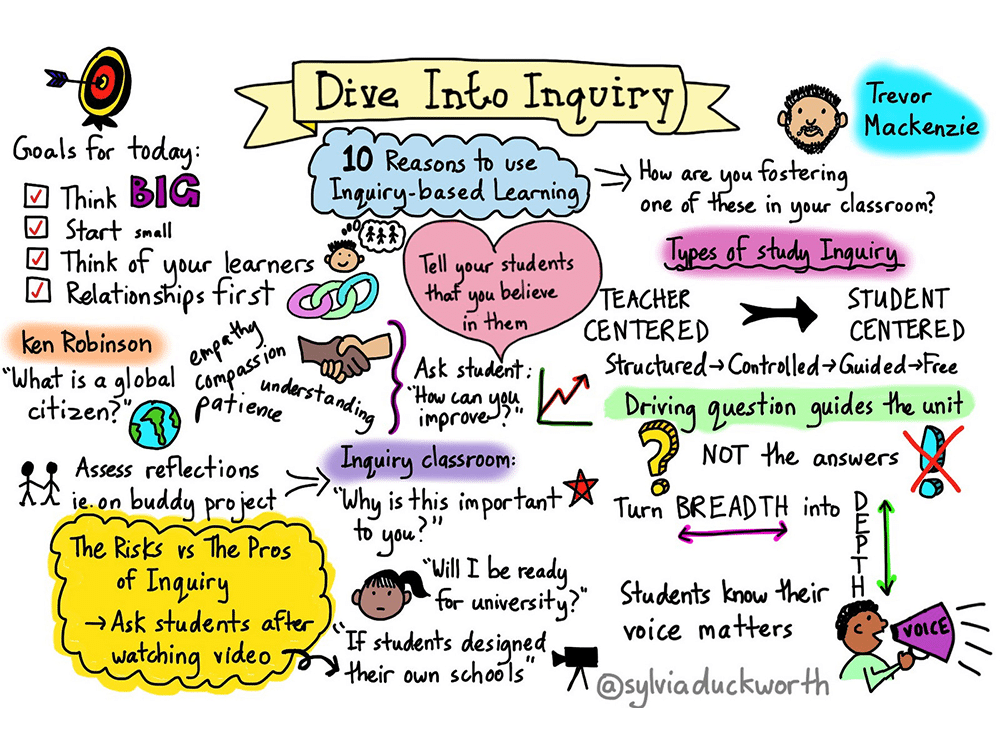
Why To Use Inquiry-Based Learning In Your Classroom
by TeachThought Staff
We’ve talked about how and when to use inquiry-based learning–and apps for inquiry-based learning, too.
What we haven’t done–explicitly anyway–is looked at the reasons for doing so. While the benefits might seem obvious (student-centeredness, critical thinking, self-directed learning, etc.), the graphic above by sketch-noter Sylvia Duckworth based on a session by Trevor Mackenzie captures a lot of these ideas in a single visual.
How Is Inquiry-Based Learning Different?
In 4 Phases of Inquiry-Based Learning: A Guide For Teachers, we took a look at the characteristics of inquiry-based learning.
Learning focuses around a meaningful, ill-structured problem that demands consideration of diverse perspectives
Academic content-learning occurs as a natural part of the process as students work towards finding solutions
Learners, working collaboratively, assume an active role in the learning process
Teachers provide learners with learning supports and rich multiple media sources of information to assist students in successfully finding solutions
Learners share and defend solutions publicly in some manner
Much like project-based learning, inquiry-based learning can look and feel and sound much different from a more traditional classroom and traditional approaches to learning. Because inquiry is unique to each child–and their background knowledge, their literacy level, their natural curiosity (and lack of curiosity), etc–it can seem ‘disruptive’ compared to ‘sit-and-get’ teaching and learning. It also can and should students to places the teacher may not have anticipated. Without planning for these characteristics, inquiry-based learning can seem ineffective, and a significant ‘waste of time.’
In 20 Questions To Guide Inquiry-Based Learning, we offered some of the kinds of questions that can guide self-directed inquiry, including:
What do I want to know about this topic?
How do I know I know it? What kinds of resources might help?
How do I know the info is valid?
Does my research raise new questions?
How do I use media to express my message?
One of the primary takeaways from these resources is the open-ended nature and diverse possibility of inquiry-based learning–for students, it can be experienced as the same difference between coloring in a coloring book, or creating a coloring book of their own.
10 Reasons To Use Inquiry-Based Learning In Your Classroom
Between what we know about inquiry and what the graphic seems to imply, we’ve added a little of our own interpretation and extracted 10 reasons any teacher–of any content area and at any grade level–should consider using inquiry-based learning in their classroom.
1. It’s naturally student-centered.
2. It focuses on questions and the process of answering those questions rather than the answer itself.
3. It promotes depth of knowledge.
4. It provides opportunities for autonomy.
5. It requires student engagement. (Inquiry-based learning won’t work without inquiry, and inquiry can’t happen without engagement.)
6. It builds soft skills–and can build confidence and relationships, too.
7. It ‘teaches students to think.’ (See #5.)
8. It provides opportunities for modeling, mentoring, and reflection.
9. It builds citizenship–digital citizenship and local/’physical’ citizenship.
10. It’s flexible and powerful. (It can drive other types of learning–project-based learning, place-based education, self-directed learning, etc.)
10 Reasons To Use Inquiry-Based Learning In Your Classroom
